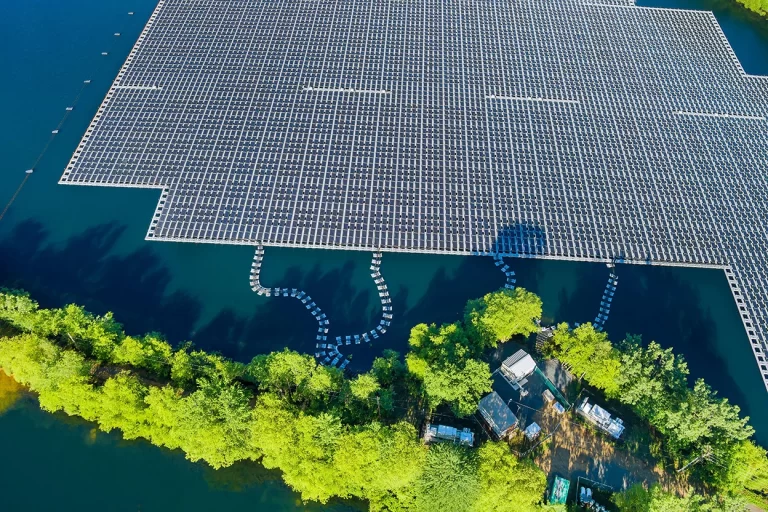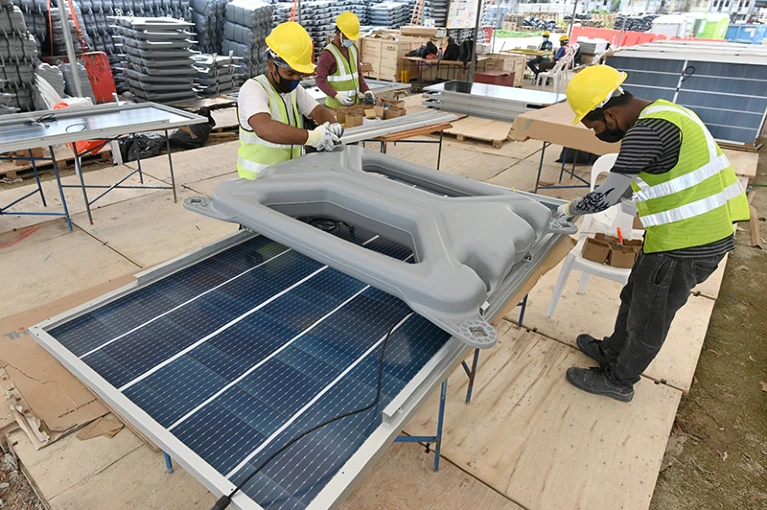
Covering 10% of the world’s hydropower reservoirs with ‘floatovoltaics’ would install as much electrical capacity as is currently available for fossil-fuel power plants.
Monitoring Desk
Solar panels need to be deployed over vast areas worldwide to decarbonize electricity. By 2050, the United States might need up to 61,000 square kilometers of solar panels — an area larger than the Netherlands. Land-scarce nations such as Japan and South Korea might have to devote 5% of their land to solar farms.
The question of where to put these panels isn’t trivial. There is fierce competition for land that is also needed for food production and biodiversity conservation. One emerging solution is to deploy floating solar panels (‘floatovoltaics’) on reservoirs.
The idea of floatovoltaics holds much promise, and there has been a rapid rise in installation and investments. But there are still many unknowns about the technology’s environmental impacts, along with its social, technical and economic dimensions.
These knowledge gaps need to be filled as soon as possible to avoid overpromising on the benefits of this approach, or having its roll-out derailed by unforeseen roadblocks.
Location, location
Solar power is space-intensive, requiring at least 20 times more area than conventional fossil-fuel plants to produce one gigawatt (GW) of electricity. Several environments have been proposed as locations for extensive installations, each with pros and cons.
Deserts have ample sunshine and don’t have much competition for land use. But even here, there are trade-offs. For example, modelling indicates that in the Sahara, the dark color of large swathes of solar panels would alter local temperatures and global airflow patterns in ways that could cause droughts in the Amazon, sea-ice loss in the Arctic and more. Solar-energy developments in the Mojave Desert in the US southwest have reduced the cover of cacti that are culturally important to resident Native Americans. And logistically, it can be hard to get energy from remote desert regions to where it is needed.
Agricultural fields are another promising possibility, but researchers are only starting to understand how pairing solar panels with crops in ‘agrivoltaic’ systems will affect food production6. Rooftops, car parks and highways are also good options, but are limited in scale.

Placing solar arrays on reservoirs could have many advantages. The arrays are simply conventional solar panels installed on floats that are anchored through mooring lines. Proximity to water tends to keep them cool, making floating panels about 5% more efficient than land-based ones. Arrays shield the surface from the sun and might reduce evaporation, retaining water for hydropower, drinking and irrigation8. Hydropower reservoirs already have the grid infrastructure for conveying electricity to consumers, reducing transmission costs. Pairing solar with pumped-storage hydropower could address the twin challenges of providing energy when sunlight is weak and storing it as potential energy in reservoirs when solar-power production is high.
Floatovoltaics might also reduce the carbon intensity — emissions per unit of energy produced — of some hydropower operations. Many hydropower plants are as low-carbon as other renewables. But for some projects, so much methane — a potent greenhouse gas — is released from decaying submerged plant matter that they can emit as much carbon per unit energy as do fossil-fuel power plants. For some of those sites, putting solar panels over just 2% of the reservoir’s surface could double the electricity production, thereby halving the carbon intensity — which is an important metric in climate policy.
For now, floatovoltaics make up a tiny part of the electricity picture. As of 2020, the global installed capacity of floating solar panels was just 3 GW, compared with more than 700 GW for land-based solar systems. But the potential for expansion is considerable, given the vast number of reservoirs worldwide — with a total area roughly equivalent to that of France. Covering 10% of the world’s hydropower reservoirs with floating solar panels would install nearly 4,000 GW of solar capacity — equivalent to the electricity-generation capacity of all fossil-fuel plants in operation worldwide.
Floatovoltaics are currently more expensive than land-based ones, but not by much: despite the immaturity of this new market, the break-even cost of floating solar projects is only 4–8% higher than that of ground-mounted solar power. The market is growing fast14, with dozens of projects under way. One, scheduled to be completed by 2024 in Batam, Indonesia, plans to produce 2.2 GW by deploying solar panels over 16 km2 of water, nearly doubling global floatovoltaic energy production.
Rapid scaling-up of any new energy technology can have unforeseen consequences. Wind turbines, for example, have harmed birds and bats, and their installation offshore can create noise pollution for marine life, interfere with whale migrations and pose complications for commercial fisheries.
Trade-offs between the expansion of floatovoltaics and environmental, social and economic goals remain largely unexplored in both concept and practice. Reservoirs are artificial ecosystems that have been critiqued for a wide range of undesirable socioenvironmental impacts. Yet, in many places, they also provide habitats for wildlife, and have an important role in fisheries and recreation. Reservoir management often serves many needs besides water supply, such as flood control and hydropower. Pressure on multiple uses of reservoirs will intensify under climate change.
Neglecting these trade-offs could increase public opposition to floatovoltaics, lengthen the environmental-impact approval process and deter private investors, thus hampering the decarbonization shift. (Click on Nature to read full article)
_________________
Courtesy: Nature